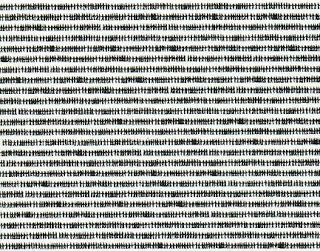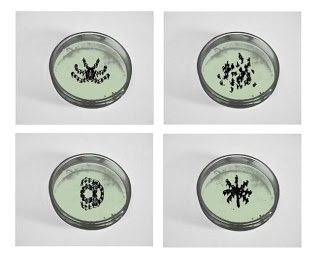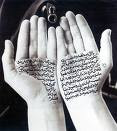8 Απριλίου 2009
MICHAL ROVNER
-
MICHAL ROVNER
-
Born in 1957 in Tel Aviv, Michal Rovner studied cinema, television, photography, philosophy, and art. Since moving to New York in 1987, Rovner has seen her work shown extensively, including at The Art Institute of Chicago; the Tate Gallery, London; P.S.1 Contemporary Art Center, New York; the Corcoran Gallery of Art, Washington, D.C.; and The Museum of Modern Art, New York. The Whitney Museum of American Art in New York hosted a mid-career retrospective in the summer.
Rovner, Michal
Rovner, Michal: “Michal Rovner: Fields
Essays by Rιgis Durand, Sylvθre Lotringer and Mordechai Omer.
Video artist Michal Rovner’s unique and ever-expanding alphabet is built of tiny depictions of the human figure. Fields documents her work in this vein over the past three years, including Data Zone, which combines the sculpture and video from her acclaimed solo exhibition in the 2003 Venice Biennale; documentation of the video installation Time Left; works from the project In Stone, including stone moving ‘texts;’ and notebook vitrines. Her recent collaboration with the composer Heiner Goebbels, Fields of Fire, which was made following a trip to Kazakhstan, depicts oil-field fires in a landscape that recalls both the fluid ink brush of the Soong and T’ang dynasty and the hyperkinetic pen of the seismograph: the notion of landscape is transformed from the symbol of constancy to an engine of metamorphosis.”
Rovner, Michal
Rovner, Michal: “Michal Rovner: The Space Between
Essays by Sylvia Wolf and Michael Rush.
By repeatedly re-photographing her images, transferring them from video to film and back again, and manipulating them digitally, Michal Rovner creates photographic and video imagery that abstract familiar subjects like houses, animals, and people into ambiguous and iconic forms. Working with representation but against the traditions of narrative and documentary purpose, her artworks imply a tentative universe, one that is paradoxically peaceful and unsettled, vivid and shrouded, and completely counter-factual. If the changing nature of art has resulted in a general blurring of boundaries–between painting and photography, reality and memory, presence and absence–Rovner mines this haziness, refuses to respect borders, and exists completely in The Space Between.”
ΕΛΕΝΗ ΚΕΣΙΣΟΓΛΟΥ: SHIRIN NESHAT
Evi Panteleon,Lucian Freud
Thus spake Freud
“I paint the sort of paintings I can, not the ones I necessarily want.”
“I want paint to work as flesh… my portraits to be of the people, not like them. Not having a look of the sitter, being them … As far as I am concerned the paint is the person. I want it to work for me just as flesh does.”
“I could never put anything into a picture that wasn’t actually there in front of me. That would be a pointless lie, a mere bit of artfulness.”
“The painting is always done very much with [the model’s] co-operation. The problem with painting a nude, of course, is that it deepens the transaction. You can scrap a painting of someone’s face and it imperils the sitter’s self-esteem less than scrapping a painting of the whole naked body.”
“I don’t want any colour to be noticeable… I don’t want it to operate in the modernist sense as colour, something independent… Full, saturated colours have an emotional significance I want to avoid.”
“Since the model he so faithfully copies is not going to be hung up next to the picture … it is of no interest whether it is an accurate copy of the model. Whether it will convince or not, depends entirely on what it is in itself, what is there to be seen. The model should only serve the very private function for the painter of providing the starting point for his excitement. The picture is all he feels about it, all he thinks worth preserving of it, all he invests it with. If all the qualities which a painter took from the model for his picture were really taken, no person could be painted twice.”
“The aura given out by a person or object is as much a part of them as their flesh. The effect that they make in space is as bound up with them as might be their colour or smell … Therefore the painter must be as concerned with the air surrounding his subject as with the subject itself. It is through observation and perception of atmosphere that he can register the feeling that he wishes his painting to give out.”
“A painter must think of everything he sees as being there entirely for his own use and pleasure. … And, since the model he faithfully copies is not going to be hung up next to the picture, since the picture is going to be there on its own, it is of no interest whether it is an accurate copy of the model.”
Lucian Freud, painter
4 Απριλίου 2009
kosmos ideon k synaisthesia
–>
<!– /* Style Definitions */ p.MsoNormal, li.MsoNormal, div.MsoNormal {mso-style-parent:""; margin:0cm; margin-bottom:.0001pt; mso-pagination:widow-orphan; font-size:12.0pt; font-family:"Times New Roman"; mso-fareast-font-family:"Times New Roman";} @page Section1 {size:612.0pt 792.0pt; margin:72.0pt 90.0pt 72.0pt 90.0pt; mso-header-margin:36.0pt; mso-footer-margin:36.0pt; mso-paper-source:0;} div.Section1 {page:Section1;}
–> Η φιλοσοφική αναζήτηση, που είχε ξεκινήσει με τους προσωκρατικούς φιλοσόφους, σχετικά με το πώς μπορούμε να γνωρίσουμε τον κόσμο γύρω μας και τις αρχές λειτουργίας του, είχε φτάσει σε αδιέξοδο την εποχή του Πλάτωνα. Οι ηρακλείτειοι υποστήριζαν ότι τα πάντα στον κόσμο του χώρου και του χρόνου συνεχώς μεταβάλλονταν. Ούτε για μια στιγμή δεν σταματούσε η μεταβολή και τίποτα δεν έμενε το ίδιο από τη μια στιγμή στην άλλη. Συνέπεια αυτής της θεωρίας φαινόταν να είναι ότι δεν μπορούμε να γνωρίσουμε αυτόν τον κόσμο, εφόσον δεν μπορεί κανείς να πει ότι γνωρίζει κάτι που είναι διαφορετικό ετούτη τη στιγμή απ’ ό,τι ήταν μια στιγμή πριν. Η γνώση απαιτεί την ύπαρξη ενός σταθερού αντικειμένου. Ο Παρμενίδης, από την άλλη πλευρά, ισχυριζόταν ότι υπάρχει μια σταθερή πραγματικότητα, την οποία μπορούμε να ανακαλύψουμε μόνο μέσω της ενέργειας του νου, χωρίς καμιά ανάμειξη των αισθήσεων. Το αντικείμενο της γνώσης πρέπει να είναι αμετάβλητο και αιώνιο, εκτός χρόνου και μεταβολής, ενώ οι αισθήσεις μας φέρνουν σε ότι είναι μεταβλητο και φθαρτο. Ο Πλάτων θέλοντας να διαφυλάξει το αγαθό της γνώσης και της αντικειμενικής αλήθειας από ιδεολογήματα που την απέρριπταν καταδικάζοντας τον άνθρωπο σε μια άγνοια μόνιμη και οδηγώντας τον τελικά στον αμοραλισμό, υποστήριξε ότι τα αντικείμενα της γνώσης, τα αντικείμενα που θα μπορούσαν να οριστούν, υπήρχαν, αλλά δεν έπρεπε να ταυτιστούν με τίποτε στον αισθητό κόσμο· υπήρχαν σε έναν νοητό κόσμο, πέραν χώρου και χρόνου. Είναι οι περίφημες π λατωνικές ιδέες ή είδη.
«Όλα είναι πολύ΄ρευστά.Πρέπεις να νίωσεις τον ήχο να κινείται.Οι ήχοι είναι ψηλοί,χαμηλοί,γρήγοροι,αργοί…Τα χρώματα μου είναι το ίδιο.Κινούνται με τον ίδιο απόλυτο τρόπο.Είναι ένα πολύ φευγαλέο συναίσθημα και αδύνατο να το προσδιορίσεις με απόλυτο τρόπο.»Το video που εχω κάνει είναι συμβολικό και στηρίζεται στην παραπάνω μαρτυρία ενώς συναισθητικού ατόμου. //www.youtube.com/get_player
Barbara Kruger
 Barbara Kruger (born 1945) is an American conceptual artist. She was born in Newark, New Jersey and left there in 1946 to attend Syracuse University. after a year at Syracuse, she moved to New York, where she began attending Parsons School of Design. She studied with Diane Arbus and Marvin Israel, who, as a graphic designer and art director for Harper’s Bazaar in the 1960s, introduced Kruger to photographers and fashion/magazine sub-cultures. after a year at Parsons, Kruger left school and started to work at Mademoiselle magazine as an entry-level designer.
Barbara Kruger (born 1945) is an American conceptual artist. She was born in Newark, New Jersey and left there in 1946 to attend Syracuse University. after a year at Syracuse, she moved to New York, where she began attending Parsons School of Design. She studied with Diane Arbus and Marvin Israel, who, as a graphic designer and art director for Harper’s Bazaar in the 1960s, introduced Kruger to photographers and fashion/magazine sub-cultures. after a year at Parsons, Kruger left school and started to work at Mademoiselle magazine as an entry-level designer.
 Much of Kruger’s graphic work consists of black and white photographs with overlaid captions set in white on red Futura Bold Oblique. The phrases included in her work are usually declarative, and make common use of such pronouns as “you”, criticism of sexism ant the circulation of power within cultures is a recurring motif in the work.
Much of Kruger’s graphic work consists of black and white photographs with overlaid captions set in white on red Futura Bold Oblique. The phrases included in her work are usually declarative, and make common use of such pronouns as “you”, criticism of sexism ant the circulation of power within cultures is a recurring motif in the work. For the past decade Kruger has created installations of video, film, audio and projection. Enveloping the viewer with the seductions of direct address, her work is consistently about the kindnesses and brutalities of social life: about how we are to one another.
For the past decade Kruger has created installations of video, film, audio and projection. Enveloping the viewer with the seductions of direct address, her work is consistently about the kindnesses and brutalities of social life: about how we are to one another.
 Kruger’s works are direct and evoke an immediate response. usually her style involves the cropping of a magazine or newspaper image enlarged in black and white. The enlargement of the image is down as crudely as possible to monumental proportions. A message is stenciled on the image, usually in white letters against a background of red. The text and image are unrelated in an effort to create anxiety by the audience that plays on the fears of society”. (Janson. p. 992).
Kruger’s works are direct and evoke an immediate response. usually her style involves the cropping of a magazine or newspaper image enlarged in black and white. The enlargement of the image is down as crudely as possible to monumental proportions. A message is stenciled on the image, usually in white letters against a background of red. The text and image are unrelated in an effort to create anxiety by the audience that plays on the fears of society”. (Janson. p. 992). In 2005 Kruger was honored at the 51st Venice Bienalle with the “Golden Lion” for Lifetime Achievement. Kruger is currently a professor at the University of California at Los Angeles.
In 2005 Kruger was honored at the 51st Venice Bienalle with the “Golden Lion” for Lifetime Achievement. Kruger is currently a professor at the University of California at Los Angeles.
In 2007, Kruger was one of the many artists to be a part of South Korea’s Incheon Women Artists’ Bienalle in Seoul. This marked South Korea’s first women’s biennial.
biennial.
Links:
www.barbarakruger.com
en.wikepedia.org/wiki/Barbara_Kruger































